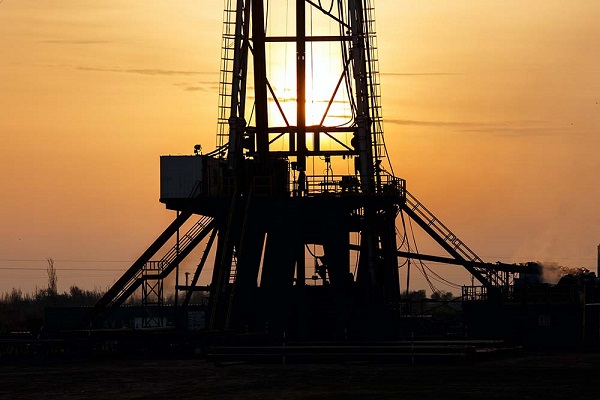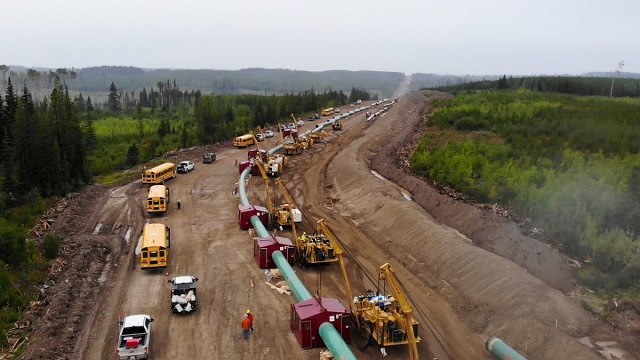Energy
Why Canada Must Double Down on Energy Production

From the Frontier Centre for Public Policy
By Lee Harding
Must we cancel fossil fuels to save the earth? No.
James Warren, adjunct professor of environmental sociology at the University of Regina said so in a recent paper for the Johnson Shoyama School of Public Policy, a joint effort by his university and the University of Saskatchewan. The title says it all: “Maximizing Canadian oil production and exports over the medium-term could help reduce CO2 emissions for the long-term.”
The professor admits on the face of it, his argument sounds like a “drink your way to sobriety solution.” However, he does make the defensible and factual case, pointing to Canadian oil reserves and a Scandinavian example.
Decades ago, Norway imitated the 1970’s Heritage Fund in Alberta that set aside a designated portion of the government’s petroleum revenues for an investment fund. Unlike Alberta, Norway stuck to that approach. Today, those investments are being used to develop clean energy and offer incentives to buy electric vehicles.
Norway’s two largest oil companies, Aker BP and Equinor ASA have committed $19 billion USD to develop fields in the North and Norwegian Seas. They argue that without this production, Norway would never be able to afford a green transition.
The same could be said for Canada. Warren laid out stats since 2010 that showed Canada’s oil exports contribute an average of 4.7% of the national GDP. Yet, this noteworthy amount is not nearly what it could be.
Had Trans Mountain, Northern Gateway, and Energy East pipelines been up and running at full capacity from 2015 to 2022, Warren estimates Canada would have seen $292 billion Canadian in additional export revenues. Onerous regulations, not diminished demand, are responsible for Canada’s squandered opportunities, Warren argues this must change.
So much more could be said. Southeast Asia still relies heavily on coal-fired power for its emerging industrialization, a source with twice the carbon emission intensity as natural gas. If lower global emissions are the goal, Canadian oil and natural gas exports offer less carbon-intensive options.
China’s greenhouse gas emissions (GHGs) are more than four times what they were in 1990, during which the U.S. has seen its emissions drop. By now, China is responsible for 30% of global emissions, and the U.S. just 11%. Nevertheless, China built 95% of the world’s new coal-fired power plants in 2023. It aims for carbon neutrality by 2060, not 2050, like the rest of the world.
As of 2023, Canada contributes 1.4 percent of global GHGs, the tenth most in the world and the 15th highest per capita. Given its development and resource-based economy, this should be viewed as an impressively low amount, all spread out over a geographically diverse area and cold climate.
This stat also reveals a glaring reality: if Canada was destroyed, and every animal and human died, all industry and vehicles stopped, and every furnace and fire ceased to burn, 98.6% of global greenhouse gas emissions would remain. So for whom, or to what end, should Canada kneecap its energy production and the industry it fuels?
The only ones served by a world of minimal production is a global aristocracy whose hegemony would no longer be threatened by the accumulated wealth and influence of a growing middle class. That aristocracy is the real beneficiary of prevailing climate change narratives on what is happening in our weather, why it is happening, and how best to handle it.
Remember, another warming period occurred 1000 years ago. The Medieval Warming Period took place between 750 and 1350 AD and was warmest from 950 to 1045, affecting Europe, North America, and the North Atlantic. By some estimates, average summer temperatures in England and Central Europe were 0.7-1.4 degrees higher than now.
Was that warming due to SUVs or other man-made activity? No. Did that world collapse in a series of floods, fires, earthquakes, and hurricanes? No, not in Europe at least. Crop yields grew, new cities emerged, alpine tree lines rose, and the European population more than doubled.
If the world warms again, Canada could be a big winner. In May of 2018, Nature.com published a study by Chinese and Canadian academics entitled, Northward shift of the agricultural climate zone under 21st-Century global climate change. If the band of land useful for crops shifts north, Canada would get an additional 3.1 million square kilometers of farmland by 2099.
Other computer models suggest warming temperatures would cause damaging weather. Their accuracy is debatable, but even if we concede their claims, it does not follow that energy production should drop. We would need more resilient housing to handle the storms and we cannot afford them without a robust economy powered by robust energy production. Solar, wind, and geothermal only go so far.
Whether temperatures are warming or not, Canada should continue tapping into the resources she is blessed with. Wealth is a helpful shelter in the storms of life and is no different for the storms of the planet. Canada is sitting on abundant energy and should not let dubious arguments hold back their development.
Lee Harding is Research Fellow for the Frontier Centre for Public Policy.
Carbon Tax
Carney fails to undo Trudeau’s devastating energy policies

From the Fraser Institute
By Tegan Hill and Elmira Aliakbari
On the campaign trail and after he became prime minister, Mark Carney has repeatedly promised to make Canada an “energy superpower.” But, as evidenced by its first budget, the Carney government has simply reaffirmed the failed plans of the past decade and embraced the damaging energy policies of the Trudeau government.
First, consider the Trudeau government’s policy legacy. There’s Bill C-69 (the “no pipelines act”), the new electricity regulations (which aim to phase out natural gas as a power source starting this year), Bill C-48 (which bans large oil tankers off British Columbia’s northern coast and limit Canadian exports to international markets), the cap on emissions only from the oil and gas sector (even though greenhouse gas emissions have the same effect on the environment regardless of the source), stricter regulations for methane emissions (again, impacting the oil and gas sector), and numerous “net-zero” policies.
According to a recent analysis, fully implementing these measures under Trudeau government’s emissions reduction plan would result in 164,000 job losses and shrink Canada’s economic output by 6.2 per cent by the end of the decade compared to a scenario where we don’t have these policies in effect. For Canadian workers, this will mean losing $6,700 (annually, on average) by 2030.
Unfortunately, the Carney government’s budget offers no retreat from these damaging policies. While Carney scrapped the consumer carbon tax, he plans to “strengthen” the carbon tax on industrial emitters and the cost will be passed along to everyday Canadians—so the carbon tax will still cost you, it just won’t be visible.
There’s also been a lot of buzz over the possible removal of the oil and gas emissions cap. But to be clear, the budget reads: “Effective carbon markets, enhanced oil and gas methane regulations, and the deployment at scale of technologies such as carbon capture and storage would create the circumstances whereby the oil and gas emissions cap would no longer be required as it would have marginal value in reducing emissions.” Put simply, the cap remains in place, and based on the budget, the government has no real plans to remove it.
Again, the cap singles out one source (the oil and gas sector) of carbon emissions, even when reducing emissions in other sectors may come at a lower cost. For example, suppose it costs $100 to reduce a tonne of emissions from the oil and gas sector, but in another sector, it costs only $25 a tonne. Why force emissions reductions in a single sector that may come at a higher cost? An emission is an emission regardless of were it comes from. Moreover, like all these policies, the cap will likely shrink the Canadian economy. According to a 2024 Deloitte study, from 2030 to 2040, the cap will shrink the Canadian economy (measured by inflation-adjusted GDP) by $280 billion, and result in lower wages, job losses and a decline in tax revenue.
At the same time, the Carney government plans to continue to throw money at a range of “green” spending and tax initiatives. But since 2014, the combined spending and forgone revenue (due to tax credits, etc.) by Ottawa and provincial governments in Ontario, Quebec, British Columbia and Alberta totals at least $158 billion to promote the so-called “green economy.” Yet despite this massive spending, the green sector’s contribution to Canada’s economy has barely changed, from 3.1 per cent of Canada’s economic output in 2014 to 3.6 per cent in 2023.
In his first budget, Prime Minister Carney largely stuck to the Trudeau government playbook on energy and climate policy. Ottawa will continue to funnel taxpayer dollars to the “green economy” while restricting the oil and gas sector and hamstringing Canada’s economic potential. So much for becoming an energy superpower.
Business
Large-scale energy investments remain a pipe dream

I view the recent announcements by the Government of Canada as window dressing, and not addressing the fundamental issue which is that projects are drowning in bureaucratic red tape and regulatory overburden. We don’t need them picking winners and losers, a fool’s errand in my opinion, but rather make it easier to do business within Canada and stop the hemorrhaging of Foreign Direct Investment from this country.
Thanks for reading William’s Substack!
Subscribe for free to receive new posts and support my work.
Changes are afoot—reportedly, carve-outs and tweaks to federal regulations that would help attract investment in a new oil pipeline from Alberta. But any private proponent to come out of this deal will presumably be handpicked to advance through the narrow Bill C-5 window, aided by one-off fixes and exemptions.
That approach can only move us so far. It doesn’t address the underlying problem.
Anyone in the investment world will tell you a patchwork of adjustments is nowhere near enough to unlock the large-scale energy investment this country needs. And from that investor’s perspective, the horizon stretches far beyond a single political cycle. Even if this government promises clarity today in the much-anticipated memorandum of understanding (MOU), who knows whether it will be around by the time any major proposal actually moves forward.
With all of the talk of “nation-building” projects, I have often been asked what my thoughts are about what we must see from the federal government.
The energy sector is the file the feds have to get right. It is by far the largest component of Canadian exports, with oil accounting for $147 billion in 2024 (20 percent of all exports), and energy as a whole accounting for $227 billion of exports (30 percent of all exports).
Furthermore, we are home to some of the largest resource reserves in the world, including oil (third-largest in proven reserves) and natural gas (ninth-largest). Canada needs to wholeheartedly embrace that. Natural resource exceptionalism is exactly what Canada is, and we should be proud of it.
One of the most important factors that drives investment is commodity prices. But that is set by market forces.
Beyond that, I have always said that the two most important things one considers before looking at a project are the rule of law and regulatory certainty.
The Liberal government has been obtuse when it comes to whether it will continue the West Coast tanker ban (Bill C-48) or lift it to make way for a pipeline. But nobody will propose a pipeline without the regulatory and legal certainty that they will not be seriously hindered should they propose to build one.
Meanwhile, the proposed emissions cap is something that sets an incredibly negative tone, a sentiment that is the most influential factor in ensuring funds flow. Finally, the Impact Assessment Act, often referred to as the “no more pipelines bill” (Bill C-69), has started to blur the lines between provincial and federal authority.
All three are supposedly on the table for tweaks or carve-outs. But that may not be enough.
It is interesting that Norway—a country that built its wealth on oil and natural gas—has adopted the mantra that as long as oil is a part of the global economy, it will be the last producer standing. It does so while marrying conventional energy with lower-carbon standards. We should be more like Norway.
Rather than constantly speaking down to the sector, the Canadian government should embrace the wealth that this represents and adopt a similar narrative.
The sector isn’t looking for handouts. Rather, it is looking for certainty, and a government proud of the work that they do and is willing to say so to Canada and the rest of the world. Foreign direct investment outflows have been a huge issue for Canada, and one of the bigger drags on our economy.
Almost all of the major project announcements Prime Minister Mark Carney has made to date have been about existing projects, often decades in the making, which are not really “additive” to the economy and are reflective of the regulatory overburden that industry faces en masse.
I have always said governments are about setting the rules of the game, while it is up to businesses to decide whether they wish to participate or to pick up the ball and look elsewhere.
Capital is mobile and will pursue the best risk-adjusted returns it can find. But the flow of capital from our country proves that Canada is viewed as just too risky for investors.
The government’s job is not to try to pick winners and losers. History has shown that governments are horrible at that. Rather, it should create a risk-appropriate environment with stable and capital-attractive rules in place, and then get out of the way and see where the chips fall.
Link to The Hub article: Large-scale energy investments remain a pipe dream
Formerly the head of institutional equity research at FirstEnergy Capital Corp and ATB Capital Markets. I have been involved in the energy sector in either the sell side or corporately for over 25 years
Thanks for reading William’s Substack!
Subscribe for free to receive new posts and support my work.
-

 Carbon Tax2 days ago
Carbon Tax2 days agoCarney fails to undo Trudeau’s devastating energy policies
-

 Business2 days ago
Business2 days agoBudget 2025: Ottawa Fakes a Pivot and Still Spends Like Trudeau
-

 Health2 days ago
Health2 days agoTens of thousands are dying on waiting lists following decades of media reluctance to debate healthcare
-

 Opinion1 day ago
Opinion1 day agoLandmark 2025 Study Says Near-Death Experiences Can’t Be Explained Away
-

 Focal Points1 day ago
Focal Points1 day agoSTUDY: TikTok, Instagram, and YouTube Shorts Induce Measurable “Brain Rot”
-

 International11 hours ago
International11 hours ago“The Largest Funder of Al-Shabaab Is the Minnesota Taxpayer”
-

 Bruce Dowbiggin17 hours ago
Bruce Dowbiggin17 hours agoElbows Down For The Not-So-Magnificent Seven: Canada’s Wilting NHL Septet
-

 Censorship Industrial Complex14 hours ago
Censorship Industrial Complex14 hours agoUK Government “Resist” Program Monitors Citizens’ Online Posts










